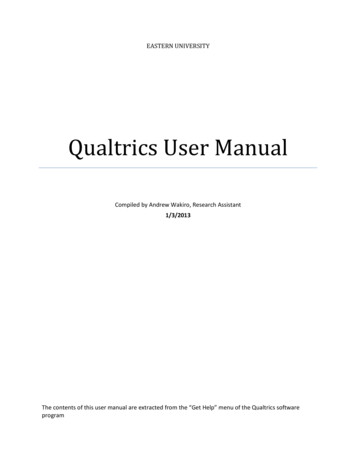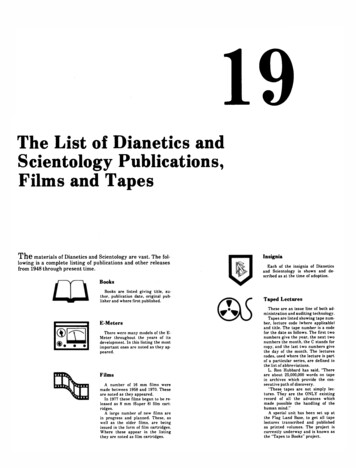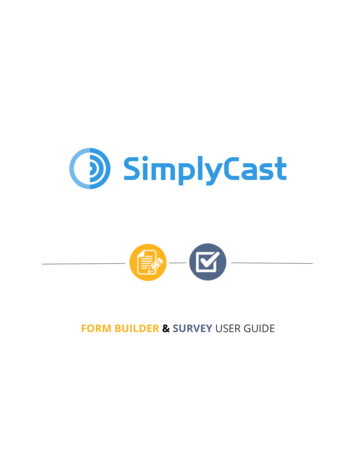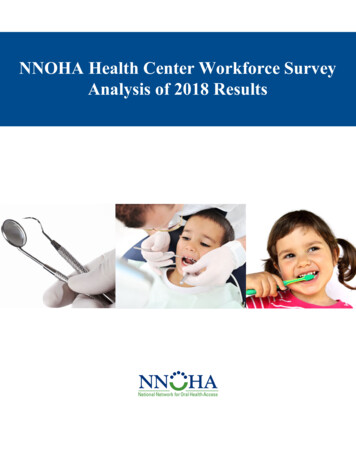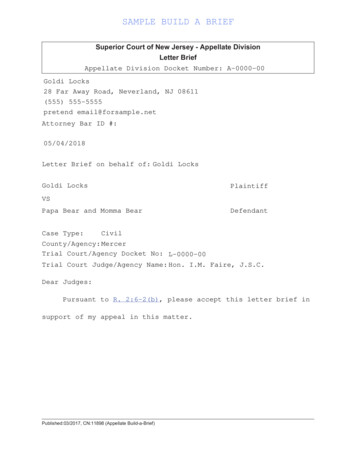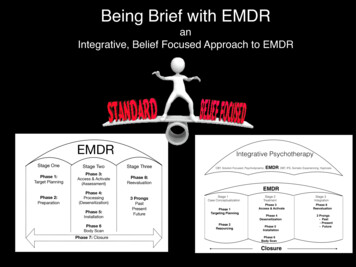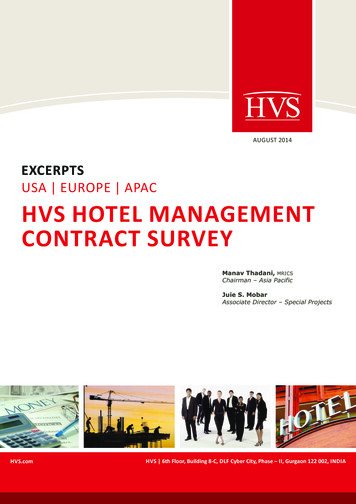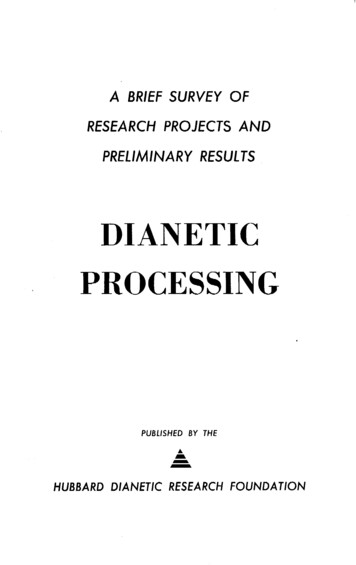
Transcription
A BRIEF SURVEY OfRESEARCH PROJECTS NETICRESEARCH FOUNDATION
PUBLISHEDHUBBARDRESEARCHDIANETICP. 0,BY THEBox502,TelephoneFOUNDATION,Elizabeth,ELizabethA CORPORATION3-295OFNEWin NewHubbard2600DianeticSouthTelephonePRINTEDL. RONINYORKILLINOISFoundationof California,Los AngelesRichondInc.11, Ill.7,Inc.Calif.7-0571OF CALIFORNIACOPYRIGHTU. S. A.HUBBARD,Y.2-5240OFStreet,A ver28,Inc.’ 9-2030A CORPORATIONThe HubbardFoundation,ResearchStreet,TelephoneJERSEYOF NEWDianetic1 1 1 East neticN.JANUARY,1957BY
dianeticprocessingA und gyResultsSouthon;
8Study10in TestBattery13Samples22on the Reportof MedicalReportsThea 383839andFuturePublications42
T. H.recenthaveIncidentof MentalandNewfordianeticandpsychoso-is thescience1950,in a bookofHealth.Researchpersonsfurtherresearchand ashington,andpersonsin theof the theoryChicago;a fewarrangementsandof conductingto its trainingto processmadeproposedHubbardDianeticof trainingqualifiedexpansionMissouri;psychicin May,thepurposesin r the twothe improvementAngeles;themostofformedin dianetictowardtheoriesThe ModernpublicationFoundation,advancesby L. Ron titledhasyears,developeddianetics,hasfiftyof psychotherapy.D.researchwhowereunableprocessingto seshastrainedresearchprogramsto furtherIn ting325dianetictechniquesonin non-profesionalauditingandwereprogramsfromas a preliminarykeptexplorethe ,(personsthe fieldprogram,theyin conjunctionhasauditorsqualifieda professionalbasis),to 1005 persons,andwithhadof rocessing.to indicatetohas givenhas set upSufficientthe trendareherewithtestedforMedicaldatafromof changespresented
a briefdescriptionThe maior contributandpsychotherapyofdianetictheoryens of dianet ic thee try to the field of psychologyare seven fu ndame ntal assu mptions:1. The primurydrive in humanbeingsis directedtowurdsurvivulfor the individual,his family,his group and his species,call of whichHumanbeingssolveproblemsof survivalare equallyimportant.fro m doingof da a they have, un less preventedPe rfect mly, in the’lightby aberration.The analyticalnl ind isso bY externalforcesorofpostulatedas the functi on of the indiv idual which solves problemssi tuations.survivalan d dire lets be haviourd uring non- emergency2. Whenforcesexternalto the individualdirectlyand immediatelythreatenhis survival,or thut of his family,groupor species,heopposesthem with violentemergencyreactions,until those forcesbecomeso strongthat they injurehim physicallyand he can nolongerresist them.At this point he becomes“unconscious”to samedegree,that is, his analyticalmind no longer functions.This happens,of course,duringaccidents,injuries,severeillness and operations.The reuctivemind is postulatedas the functionwhichdirectstheemergencyreactionof an individualunder severestress.The nearerthe individualapproachesunconsciousnessand deuth, the more completelythe reactivemind controlshis behaviour.3. Whenan individualis “unconscious”,he continuesto recordsensationsin detail,thoughthese do not become“conscious”.Therecordingincludesall soundsand tactile impressions,as well as thepain whichaccompaniesthe injury or illness whichcause the “unconsciousness”.The unconsciousnessmay be momenturyand mildor protractedand deep.The engramis postulatedas the recordingof any momentof pain and unconsciousness,long or short, with itsaccompanyingsensationsof sound, pressure,and so on. There is noassumptionUS to the locationof this recording,thoughthereareindicationsthat it may be locatedin the cells, or in the mid-brain.The materialin the engramis not availableto the analyticulmindunderordinaryconditions,since the analyticalfunctionwas interruptedduring the recording.4. Afterthe individualhas recoveredfrom the periodof unconsciousness,if a situationsimilar to the engramicsituationoccurs,thewill interprettheengramwill be “keyedin”; that is, the individualnew situationas a dangerousone, due to its similarityto the oldincidentwhichactuallywasdangerous.Whenthat happens,thereactivemind takesover the directionof behaviour,as it does inactual emergencysituations.
5. After the key-insituation,any stimulussimilar to one presentinthe engramwill act us a sign of an emergency,the engramwill berestimulated,the analyticalmind will be attenuated,and the reactivemind will directbehaviour.Thus, the individualwill act as if therewerean emergencypresentwhenthereis none.6. Whensuch restimulationoccurs,the individualliterallyobeysphrasesrecordedin the engram.The reactivemind does not evaluateor differentiate.Since the analyticalmind is not functioningto solveproblems,the engramitself becomesthe patternof behaviour,rigid,repetitiveand irrational.7. The aberrativeeffect of these engramscan be removedif theindividualis returnedto the moment of the occurrenceand can recallthe engramin perfectdetail,whilefully conscious,und recountitseveraltimes,In this way,perceptionsand sensationswhichwerenot previouslyavailableto the analyticalfunctionbecomeavailable,and are open to adequateanalyticalinterpretationand evuluationby the individual.Thus they will no longerbe interpretedby theindividualas signs of an emergencysituation,and will no longerhave the power to awukenthe reactivemind to emergencybehaviour.It is obviousfrom the abovedescriptionthat a basictheoreticalpostulateis that the analyticalfunctionis capableof refineddifferentiations,whilethe reactivefunctiondoes not differentiateat all.That is, it identifieseverystimulusin a situationwiththe totalsituationand is unableto distinguishbetweenthem or to evaluateproperlythe total situation.Furtherrefinementsof the theoryintroducethe Tone Scale, whichisthe patternof emergencyreactionand can be readilytraced.Whena strong threat to survivaloccurs,the individualattemptsto deal withit aggressively.Failing, he reacts first with boredomand indifference,uttemptingto escapefrom the threatinto otherfields of uctivity.If he cannotescape,and the threut cornershim, he becomesangryand tries to destroyit. If h e is not successful,a fear reactionoccursand he makesviolenteffortsto escape.If he cannotescape,herelapsesinto apathyand finallyunconsciousness.Every time the engramis restimulated,it gains in force and tension,and is more liable to later restimulation.Such incidentsare calledlocks or secondaryengrams,dependingupon their severity,and areroughlyanalogousto momentsof “psychictrauma”of the olderpsychotherapies.
The specificpatternof behaviourduringmomentsof restimulationiscomplex,dependingupon the natureof the engram,and the natureof previousrestimulations.But whateverthe pattern,the individualwill obeyliterallythe phraseswhichthe engramcontains.Thesephrasescan reduceanalytica)function,lead to eccentricand inadequatebehaviour,and cause psychosomaticillness.Many psychotherapieshave been based on the assumptionsamongstmanyothersless pertinent,that a.) aberration,includingpsychosomaticillness,is causedby trauma;b.) pretationof an innocuoussituationas a dangerousone; c.) thinkingin identitiesis the basic cause ofmuch misinterpretation;and d.) the effectof the traumacould berelievedby recallingit.However,dianeticsadds to these assumptionsthe new conceptthattwoseparatepsychicfunctionsexist,one whichis situationswithouterror,and anotherwhichproducesstereotypedreactionpatternsas emergencyreactions.Dianetictheoryalso introducesthe conceptthatthe sourceof these stereotypedpatterns,the basic cause of aberration, is a momentof pain or unconsciousness,when the analyticalfunctionwas interrupted.Further,the conceptof literal obediencetophrasesheardduringmomentsof unconsciousnessis a new fundamental.These thre e postulate s c onstitutefrom t he th eories of ot her psychotha briefdiscussionofthe ma esenewassumptionslead to radicaldeparturesin technique.Dianeticprocessingis based on the ability of human beings to returnto any periodof their lifetimeand recountit in detail.“Return”asused in dianetics,differssomewhatfrom whatis ordinarilyunderUsuallythe most efficientmethod of rememberingstood as memory.is to take frompast experienceonly thoseparticularfactswhichare pertinentto the problemin hand, withoutrecallingpast experiencesin detail.Many persons“return”quite naturally,purticularlyAs they recall a situation,they arein recallingpleasantexperience.able to feel again the sensationsand perceptionsthey felt duringthe actual experience.Visual,auditory,olfactory,tactileand tasteimageryhave been showntoo often to need furtherdemonstration.They have been noted not only in the field of psychology,but alsoin the variousarts, and in ordinaryliving.Children,particularly,8
re turntonaturallyreturn evenDianeticreturn tofully alertin no wayother thanandwhenfre quentl y. Dianeti c methodspermithe does not do so spontaneously.u pre-cleartechniqueis directedtowardenablingthe individualtomomentsof pain and unconsciousnessand recall them whileand awake.No hypnosisis used, and dianetic“reverie”issimilar to a hypnotictrance.No positivesuggestionis usedasking the individualto return.Since engramcommandsare obeyedliterally,and since the basiccause of aberrationis postulatedso definitely,it is not necessarytoresortto the randomand time-consumingmethodsof free association in orderto recoverpast experienceswhichare occluded.Theauditorsimplydirectsthe attentionof the pre-clearto incidentswhichcontainphrasesthat are importantto the pre-clearand seemto directhis behaviour.The auditordoes not suggestthe phrases,but discoversthem by questioningthe pre-clear.When the pre-clearhas returnedto momentsof pain or unconsciousness, or momentsof intense restimulation(psychictrauma),the auditorhelps him to recall every detailby askingquestionsas to what thepre-clearsees, hears,feels,smells,and so on. The auditorthentakesthe pre-clearthroughthe nd perceptions)until the pre-clearis eitherboredwith the incidentor finds it highly amusing,One of the mostsatisfyingresultsof dianeticprocessingis this intenseamusementund feelingof well-beingthat developsin a pre-clearafter runningu severeengramwhich,on first contact,causedphysicalpain andanxiety.In developingdianetictechniques,Hubbardfoundthat engramscouldbe recoveredmore easilyif the earliestincidenton a chuinof similarengramswas run first.Thus he attemptedto returnthepre-clearto the earliestmomentpossible.As he continuedto work,he found that pre-clearsbegan to recall their birth.Though surprising, this was not new, since psychoanalystshave reportedmemoriesof birth.But in furtherwork,pre-clearsbegun to report memoriesofprenatalexperiences.At first thesememorieswereviewedwithscepticism,but they soundedso completeand realistic,the subjectiveexperienceof them was so intense, and the sensationsreportedwereso exactlyrelevantto prenatalconditions,thut they were tentativelyacceptedas valid.Furtherworksoondemonstratedthat excellentresultscame fromrunningthese prenatalengrams,and earlierand earlierincidentswerefound.Althoughsuch memoryseems surprising,workersinother fields have reportedprenatalmemory,and recent experimentshoveshownthata foetusdoesrespondto soundsoutsidethe
maternalbody,to moderateand loud voicesas well as to bells,buzzers,and so on.No one supposesthat the embryoor foetusunderstandswordsthat are spoken.But a recordingof sensations,includingsoundwaves,is certainlybiologicallypossible,and if thepatternis there, it can be keyedin and restimulatedafter the babyhas learnedthe meaningof the sounds as words.At present,prenatalengramsappearto be highlyimportantinaberration.They can be discoveredin everyindividual,and seemto be the sourceof much of the unhappiness,inadequacyand illnessthat so haunts our society.Dianeticauditorspreferto use the terms“processing”insteadof“treatment”or “therapy”,and “pre-clear”ratherthan “patient”,simplybecauseof the unfortunateconnotationsof the older terms.Few peopleare using their full capabilities,for all of us have aberRatherthan infer that the wholerationsof one kind or another.populationis ill, dianeticists,on their evidencepreferto take thestandthat everyonecanbe a highlyconstructiveand creativeindividual,and that everyoneis interestedin becomingso.Thus,they look upon dianeticprocessingmore as a removalof obstructionsthan as a treatmentof illness.thepurposeIn choosingudministeredand afterinterestingan adjunctofthisstudystudentsfor the professionalclasses,the Foundationpsychometrictests.The resultsof these tests,beforeprocessing,havebeen collectedand studiedand areenoughto justifypresentation.The study was begunasand is in no sense definitive.to the trainingprogram,In additionto these data, cases are presentedwhichshow improvement in psychologicaland physicalconditionsduring dianeticprocessing.Individualsapplyingfor processingat the Foundationare required to have a medicalexamination,either by residentphysiciansat the Foundation,or by their family doctors.If the medicaldiagnosisshowsevidenceof presentabnormalities,they are requestedto haveperiodiccheck-upsduringthe courseof processing.Ratherremarkable improvementhas appearedin some cases, and a few examplesof theseare presentedas a preliminaryreporton intensiveandcontrolledstudies in s studentsreceivetheir training.10are, of course,givenprocessingduringtheirlearn auditingby practicingit upon each other.processingvaryingfrom 50 to 100 hours during
ofUsepsychometryindianeticsThe purposeof this sectionis to outline the problemsinvolvedwhenmental tests of the stundardtype are used as instrumentsof measureSince mental processesare measurablement in dianeticresearch.only in the individual,objectivemeasurementsof such processesarethereforea sine qua non for dianeticevaluation.If dianeticresearchis to be definedas “the study of human behaviourfor the purposeof discoveringand removingthe sourcesof aberration”,or, in other words,as the scienceof mentalhealth,a needarises for tools with which to pursue that study.Actually,such toolsas do exist may or may not applyto the dynamicsof dianetics,since its methodologyhas no exactparallelin the historyof psychology.It is just this that posesa perplexingproblemto theresearcher.To quantitativelymeasurechangeswhichcome aboutas a result of diuneticprocessing,the researcherhas no choice butto use psychologicaltests in commonuse throughoutthe country,althoughtheir suitabilityfor such a purposeis at presentan openquestion. *The solutionto the wholeproblemlies, of course,in the settingupof new testinginstrumentsdesignedspecificallyto measurethefunctionsand factorschangedin dianeticprocessing.The obviousmagnitudeof such an undertaking,however,makesit prohibitiveat the presenttime.Tentativerecommendationsalong this line are,nevertheless,under way.Newdevelopmentsmuy be lookedfor inthe future.For our presentstudies,therefore,use has been mude of those testing instrumentsjudgedby a groupof psychologistsas most appropriatefor diuneticpurposes.A thoroughcanvassof the testingfield wus made us well us a careful sifting out of pertinentduta frommany divisionsof psychologicalstudy.As a result of this survey,the tests finally selectedincludedsuch well-knownscales and measuring instrumentsas the d Adults;the MinnesotaMultiphusicPersonalityInventory;the CaliforniuTest of Mentul Muturityfor Adults; the Allportthe BernreuterPersonalityInventory;theVernonStudy of Values;JohnsonTemperamentAnalysis;the CaliforniaTest of Personality;theCaliforniaMentalHealth Analysis;the Pintner GeneralAbilityTests;the Otis Tests of MentulAbility;The MinnesotuPaperFormbourd;the MinnesotaClericalTest; and others.In additionto these more*Mosttestsusedto showchange,aresultdifferentat theirvalueisandafterquestionable,existingstate,in beencomeindicatedesignedaboutastwotherapy.11
generaltests,somespecialexperimentalRorschach,the ThematicApperceptionTest,The generaltion,sortingclassificationand graphicresults.casesweregiventheand the Szondi Test.statisticalprocedurein the testing programis the collecand assemblingof all data;the condensationandof data;the presentationof data in textular,tabularform;and finally,the analysisand interpretationofThe mental test methodemployedis mainlythat of time-studiesorretests.In this method,the same individualor the same groupofindividualsis testedat differenttimes:once beforeprocessingisgiven,and againafter a numberof hours of processing.The twotest resultsare then comparedto ascertainwhatquantitativedifferences,if any, show up. The attemptsso far made in this respecthave producedinterestingand, in fact, significantresults,Generallyspeaking,the differencebetweeninitialabilityand desirablepersonalitytraits shownon the pre-tests,and the improvementindicatedby resultson the retestis greaterthan can be accountedfor onthe groundsof normal variation.The purposeof the preliminarytesting programwas merely to screenupplicantsfor the professionalcourseand to assistauditorsinclassifyingsubjectsaccordingto level of intellectualubilityanddegreeof emotionalstability.The intentionto use the test findingsof this particularseries as objectivemeasurementsof diuneticchangein the pre-cleardid not arise at the time.This came later when theresults appearedto be significantfrom this point of view.Individualchangesin test scoresbetweentest administrationswasto be expectedin any case, but score increasesas a consistenttrendfor entire groupswas somethingon a differentorderand openedawidefield for investigation.That such findingscameaboutwasencouragingand, after statisticaltreatmentverifiedthe findingsandshowedthem to be significant,it was decidedto presentthem forwhat they are worthin bookletform.Whenit did becomeapparentthat psychometricapplicationobiectified changesdue to dianeticprocessing,speculationaroseas toh appenwhat wouldif such a large seriesof cases werea rigidlycontrolledexperimentset up to test the results.Such an experimentis now under way.This study will providea checkon the findingsfrom the initial test programsince it is possiblethat such findingscould occurby chancein any randomsamplingof the populationwhen no controlgroup is used.In the experimentnow being set up,however,both a controlgroupand an experimentalgroupare tobe used and equated,insofaras is possible,in age, sex, generalrace, and socioeconomicstatus.On completionof thisintelligence,study,the results will be releasedto the public.121
summaryof resultson the preliminarytest batteryThe administrationof the first batteryof tests took place from midAugustto mid-September,1950 at the Los AngelesDepartmentofthe Foundation.The studentswere testedbeforeprocessingand asecondbatteryof tests was given after they had completedtrainingand receivedthe processingincidentto training.For one reasonoranothera few of the studentswere unable to completeall the tests,which explainswhy, on the accompanyingdiagrams,the numberofcases varies somewhatfrom one test summaryto another.Only thosestudentswho took both batterieswere,of course,used in these finalsummaries.The batteryconsistedof the CaliforniaTest of MentalMaturity,theJohnsonTemperamentAnalysis,the CaliforniaTest of Personality,the MentalHealth Analysis.These tests were chosenfor preliminaryrough screeningof studentapplicants.The CTMM has the advantageof measuringboth languageand non-languagefactorsin a shortform.The three personalitytests measuredifferentaspectsof personalityand have been found valuablefor use in schools and clinics.*TheCaliforniaTestof MentalMaturity,ShortForm,wasboth pre-testand re-test,since no alternateform wasworkhas been done on the re-testreliabilityof thislishers state in their literaturethat evidencewhich theythat there seems to be no learningfactoron a repeatgiven withi n a few months of the first test, unless thehad an opportunityto study the test in the meantimegivenonavailable.Notest.The pubhave suggeststest even whensubjectshaveor are givenspecialinstructions.Naturally,no studenthad accessto the test.They werenot informedthat they wouldbe retestedon the sameform.Some practiceeffect probablyoccurred,and for that reasongains of less than five IQ points are not significant.However,the high proportionof gains as comparedwith losses, aswell as the frequencyof gains abovefive points,and even aboveten points,suggeststhat a learningfactorwouldnot accountfor thetotallackpictureofof ins,re-testBut it must be recognizedthat, due to thestatisticsor a controlgroup,the figuresandon the CaliforniaTest of MentalMaturitycan in no way be consideredconclusive.by(s. Southon,Psychometrist,underthedirectionofareD. Ibanez,onlyPh.D.13
The practiceeffect on objectivepersonalitytests can be considerednegligible.A personwho has insightinto the test questionsandwishesto falsifyhis answersmay, of course,do so, We feel thatthere was less incentivefor our subjectsto overevaluatethemselvesthan wouldbe the case when such tests are used, as they commonlyare used, for screeningin industryand educationalorganizations.By the same token,there was less incentivefor them to falsifythere-teststhan the pre-tests,since-thefirst tests were used for screening, and the last simply as a check.Thus, gains on the three testsof personalitycan be consideredvalid withinthe limits of validityof any obiectivetest of personality.The findingsfrom the intelligencetestingare illustratedin Figure 1.In the first place, the graphis aSeveralpointsshouldbe noted.summaryof the numberof points of gain and loss in IQ scores,undnot of the IQ scoresthemselves.The heavyhorizontalbar thatextendsacrossthe chart,separatingthe pointsof gain fromthepoints of loss, representsthe IQ score of each subjectat the time ofthe first testing.The points of gain or loss on re-testingare indicatedby means of straightlines perpendicularto the horizontalbar, eachverticalline representinga single case. The verticallines that extendupwardsfrom the middle bar indicateby their height the number ofpoints gainedin IQ, while those that extendbelowthe bar indicatethe number of points of loss in IQ.The total numberof cases is 88, and the time-spanbetweentest andre-testwas approximatelyfour weeks.The group was not only unIt comprisedselected,but also to a high degreeheterogenous.personsrangingin age from 22 to 66 yearsand of both sexes ofwhich 59 were males and 29 females,Comparisonof the test resultsshow4 cases with no changein IQ on the re-test,only 6 showingICES, while78 showedIQ gain.Whereasthe maximumloss is only9 pointsbetweentests, the maximumgain is as high as 26 points.It will be noted that, percentagewise,4% of the 88 cases showednochangein IQ, and 24%fell withinthe limits of expectedvariationpoints).Beyond these, 2 % showeda significantloss and( or -570%showeda significantgain.In terms of points of gain, 42 o/oshoweda gain of 6-l 0 points;18 ‘A showeda gain of 1 l-l 5 points;4% showeda gain of 16-20 points; and 6% showeda gain of over20 sonlevelofconfidence.meansonis significanttest-re-testat sassumptionis5pointsyieldsis(whicha t ofmadeisthatques-
GRAPH SUMMARYOF GAIN AND LOSS IN INTELLIGENCESCORESfa&n befoe dnd U&W Diunetk 8 STUDENTS,.,.OF MENTALNMXVRITYaverage variofion of test without processing. srph. or before processiigtest given mid augurf195’0mid auqustortdDIANE’TlC PROCESSINdgiven betweenmid september1950af?ef *st given mid september1950f:#:t1tat9l ntbIb:32----:.CoPYRlOwrwta3457i fteach vertical---- I-line representst&san indr’viduoladministeredFigurecaseby115
The actorsinvolved,a similarIn some casesretesting.improvementonmarked,whilein s no changeat all,is one of unmistakeablefor the entireIn Figure 2, the personalityby two lines, the brokenshiftbut the over-allcomponentsare, in each case, representedline for the first test resultsand the solidcomponent,the linepercentilegroup.medianIn a generalscorenumberof casesIt canNotegeneralheadingre-testline wellthatin nearlyespeciallyextendsto thescorebe referredin rankall componentshigherhow“Socialof theto as theorder.anythepointthanThe totalpoint“Communityof 55 percentileon the e at medianRelations”a gaingroupthatall the rrangedis at a considerablypre-test.oftheof scoresmedianis 76.be seenin oneway,of a setofgroup.themiddleshow,in the directionFor eachline for the retesting.point on the scale whilemarksthe re-testtheon theFor example,re-testaboveunderpositionsline.onfor themedianofthe pre-test85median30.In mentalin Figurecategorythere-testagainmedianSo farbasisof the resultsa 15percentilethe medianscoretrendonweparisonscorehavebeenof the groupis to use averages.healthtestsin mostconsideringpercentile4, 5, andgain6.overhere,is illustratedon the re-testcomparisonsscores.AnotherThis methodThe first tworespectively,sincethe generalabove.pictureof the test,the firstwhiletestshowsresults,is wellonandabovethecategories.betweenwayandreferis similartestsof makingon thethe com-its results are illustratedto the personalityandthe thirdfromthe JohnsonTemperamentAnalysis,The personalityand mentalhealth diagramscussedre-testingof all sub-divisionspointon the pre-testof medianin Figuresmentalimprovement3. The medianpercentilepositionis againused in eachfor comparisonbetweentests.The Total Score point, whichis a summation16comparisonstrendtowardsignificantthe improvementis notillustratesexpressedrequireto the findingsthe findingsin averages.little commentalreadydis-
SUMMARYOF CHANGESIN PERSONALlt’YCQMPONENTSIN 76 CASES BY MEWANPERCENNLPAS SHOWNSCORWOF PRe-TEStttUGPRE-TEST:SELFmid voussymptoms151016SOCIAL20253035 0465055606570758085909599404SSO 55606570758085909599ADJUSTMENTtotal ;octoladjustl?enfsocials tartdordssocialSkillsonti-Socialtendenciesfom ii4jralatronsoccu ionrelo .ustmentPRE-TtST!%85RE -TESTL5HUBBARDDlhWEtuRCSEARCUFOWDATIOUFigure217
MENTALO# F 73 CASESaugust WiOLlA6IWfIESr-dPERSONALfreedomTESTINGPOST ONSFOR EACHCATEGORYmid freedomfromfeelingsofinadepuocyfreedomfrom sense bfph 675809690959975RE-TESTASSETStofalassetsC/OS e 1015202s303540TotALP-RE-TEbT fHUBBARDDIANETICRESEARCNFOUNDATIONFigureia360
OF AVERAGEPERCENTILESCORESON CALIFORNlATEST OF hnenttoccupation1015202535404550556065707580 sonoloffreedomnervousselfFOR EiCHRE- TEST-w-w-PRE-TEST:adJ’uSfmsntSCORES OF 76 mSymp oms- reliancefreedomw;thdmwinyfromfendenciessense of belongingpersonalfreedom15eo25a. . .A. HIJBBARDDIANETlcRESEARCNSIGNATUREFOU,UPAT ,UFigure419
OF AVERAGESuMMARYPERCENTILESCORESONMEdVZiAL HEAL7YHANAWSIS9ASEOtofalON iesSCORbSOF mmanifestationsfreedomfeelinqsf ramof inadepacycloseimmafuritysatisfying20 2530354-O 455055 6065 7075 goalsandworkandrecreationsocialparticipation1 5loPSYC”OMEfRlST, t. aSIGNATUI(F -HUB6ARODlANErlCRESEARCHFOUNDAttONFigure205
TEMPERAMENTFORt-est taken TSO STESTINGGROUP OF 73RESULTSCAS&S, . . . , 3oHNso tested.,beforetestgivenDIANETKPROCESStNGadmid sepfemberIcj5Oprocessingyivevrafter estANMYSIS PRO0U.ETEMPERAMENTSTUDENT973givenmidthis qmph representsthe average percentilemitt1950mid uyusftT50Septemberscoresaugustbtfweerron each categorysyrnpatheficcordialtiveucselfmasteryagy resivedepressivecri ica/nt?
The most recent development is the science of dianetics, introduced by L. Ron Hubbard in May, 1950, in a book entitled Dianetics: The Modern Science of Mental Health. Since publication of the book, the Hubbard Dianetic Research Foundation, form
